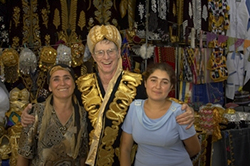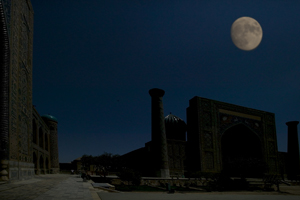
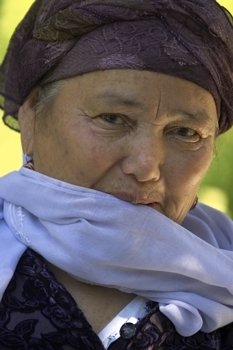
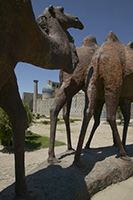



Quite frankly, there are some parts of the world one never expects to see, no matter how well traveled you may be. Although I'd heard of Uzbekistan, and perhaps the smaller country, Kyrgyzstan, as well, I know I couldn't have located either country on a world map. Both countries are located in the far south of what was formerly the Soviet Union, with a very small area of Uzbekistan bordering Afghanistan and eastern Kyrgyzstan abutting western China. Fortunately for me, one of our friends and course participants, Ilya Raskin, was involved with a botanical project in Central Asia in conjunction with Rutgers University, and he invited me to speak on biodiversity to scientists in both countries. I eagerly accepted, and thus began my adventure to Central Asia.
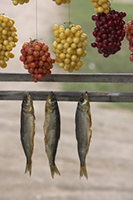
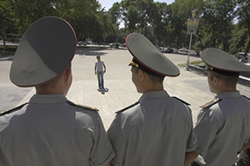


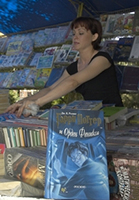
The 'Moslem countries with 'stan' in their name have certainly made news. Pakistan and Afghanistan are familiar to everyone, but the others -Turkmenistan, Tajkistan, Kazakhstan -- are black holes in the world map for most people. Admittedly, I had some degree of concern traveling to this part of the world, as I wondered what the sentiment of the locals would be toward Americans, and if the conditions would be safe. Worries, it turned out, that were absolutely groundless.
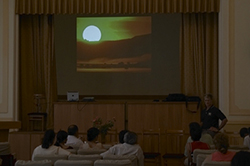 I presented three lectures in these two countries,
and at the last, at a University in Tashkent, I was asked what
my impressions were after visiting this area for the first time.
My answer was that I was genuinely impressed by the friendliness
of the people, by their hospitality and their warmth. Although
I normally don't photograph people I enjoy doing so when I have
the opportunity, and both of these countries were target-rich
and photo-friendly environments. Most of my shooting in the two
weeks traveling involved cultural and human subjects, and it was
great fun.
I presented three lectures in these two countries,
and at the last, at a University in Tashkent, I was asked what
my impressions were after visiting this area for the first time.
My answer was that I was genuinely impressed by the friendliness
of the people, by their hospitality and their warmth. Although
I normally don't photograph people I enjoy doing so when I have
the opportunity, and both of these countries were target-rich
and photo-friendly environments. Most of my shooting in the two
weeks traveling involved cultural and human subjects, and it was
great fun.
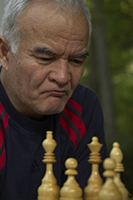
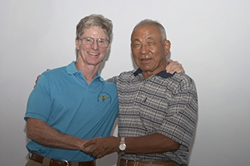
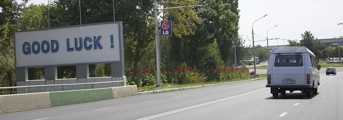 Left: A
'good luck' sign at the entrance to the Uzbek airport. Is this
saying anything about the conditions of the airlines or the safety?
Left: A
'good luck' sign at the entrance to the Uzbek airport. Is this
saying anything about the conditions of the airlines or the safety?
Living conditions were great, although in some ways at times I felt as if I was on a central Asian version of the TV show 'Fear Factor,' for the food was at times quite different from what I was accustomed. At one outing in Kyrgyzstan I was presented, as the guest of honor, with a lamb's head on a platter and was informed that as the special guest I'd be given the left eyeball to eat. 'Only the left eyeball. That's special,' one of my host's remarked. I envisioned popping the cooked eyeball, feeling a squirt of vitreous fluid as I bit down ... you get the idea, but as it turned out the eyeball isn't eaten, only the fatty, muscular tissue around and behind the eyesocket which was, believe it or not, quite acceptable. Now the lamb's ear, eaten at the same time, well that isn't something I'd order out. Fermented horse milk, horse meat, tongues, testes, you name it, I had a varied fare, but all of it tasted fine or was truly delicious and I certainly didn't lose weight on the trip!
Central Asia is, in fact, the breadbasket for the world, and many of our crops and grains developed somewhere in these regions. Watermelons and a watermelon-shaped white melon that tasted like the richest, most delicious, almost meaty melon I've ever had, were the best I've sampled anywhere. Tomatoes and strawberries seemed to be an entirely different fruit compared to their US counterparts, and lamb -- I'm talking about the 'normal' parts now -- was the best I've ever had. Lamb is common in many parts of the world and I'm always amazed when I see someone order lamb at a US restaurant, for my experiences in Argentina, the Falklands, India, Chile, and Kenya had not made me a fan. However, within a short time I was ordering lamb at the Uzbek restaurants -- it was the best, and I now may be tempted to try US lamb.
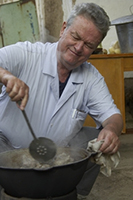

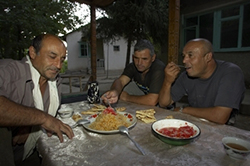
Food, in many ways, was a celebration, for we were honored guests, and the meals were served and eaten in a relaxed manner we don't see at home. It was common to have a communal dish where people simply reached in with a hand or fork or knife for the next portion. Bread, outstanding rich bread, was pulled apart by hand and passed about. At one lunch early on in the trip, at a remote park in eastern Uzbekistan, I was passed a cup for tea. Inside, the cup was ringed with residue, but with my thumb I swiped it clean, presented my cup, and drank. Throughout the trip I didn't get sick, and no one of our group of five did either. I call attention to this not to point out a lack of sanitation here, which was not the case at all, but to contrast the much more laid back and relaxed sense of eating, as opposed to the almost neurotic sense of cleanliness and aversion to 'eating after one another' that westerners so often have.
 To illustrate, we 'crashed' an enormous wedding
party in Samarkand, Uzbek., where our host had been invited and
had brought us along. Word must have preceeded us because a table
was prepared and everyone greeted us with warm smiles, nods, and
handshakes as we entered the huge hall. After settling in and
grabbing a few bites the photo opportunities proved too much and
Ilya and I began roaming about snapping photos. I mounted a set
of stairs to get an overview of the hall, but unfortunately my
vantage was the entranceway for a large side room where the overflow
guests were seated. A man appeared and beckoned me inside to see
the room and take some pictures there. Everyone inside -- a hundred
or more people, turned to watch, then waved or beckoned me over
to take their pictures. I started doing so, but quickly discovered
that a photograph would cost me ... with a drink. After taking
a photograph of a group, those included insisted that I proposed
a toast -- a mere heads up gesture sufficed -- and down the shot.
I did so, and was given a Mountain Dew-looking drink to chase
down the shot. The Mountain Dew was someone else's drink, of course,
which I had to tap into again after I had another shot and needed
my 'chaser.' No worries about drinking after me, nor me after
him ... a pretty neat testament to humanity I thought.
To illustrate, we 'crashed' an enormous wedding
party in Samarkand, Uzbek., where our host had been invited and
had brought us along. Word must have preceeded us because a table
was prepared and everyone greeted us with warm smiles, nods, and
handshakes as we entered the huge hall. After settling in and
grabbing a few bites the photo opportunities proved too much and
Ilya and I began roaming about snapping photos. I mounted a set
of stairs to get an overview of the hall, but unfortunately my
vantage was the entranceway for a large side room where the overflow
guests were seated. A man appeared and beckoned me inside to see
the room and take some pictures there. Everyone inside -- a hundred
or more people, turned to watch, then waved or beckoned me over
to take their pictures. I started doing so, but quickly discovered
that a photograph would cost me ... with a drink. After taking
a photograph of a group, those included insisted that I proposed
a toast -- a mere heads up gesture sufficed -- and down the shot.
I did so, and was given a Mountain Dew-looking drink to chase
down the shot. The Mountain Dew was someone else's drink, of course,
which I had to tap into again after I had another shot and needed
my 'chaser.' No worries about drinking after me, nor me after
him ... a pretty neat testament to humanity I thought.
However, things were about to get rough. The next table beckoned me over and I took another photo. Another shot followed, and while I was pleased to impress them that I could indeed down a Vodka shot with one quick pull, I knew this was about to get out of hand. The next table waved me over, but I smiled, shook my hands, pantomined taking another shot and pointed at my camera, and said in English, 'No way, I gotta get out of here!' Although no one probably understood my words they understood my intent and laughed, while I scooted back out into the main hall. Otherwise, my friends and I might still be knocking back shots!
This friendliness was exhibited everywhere. Of the hundreds of people photos I made, I'd estimate that less than a half-dozen times did someone decline my request for a photograph. More often, people were jumping IN FRONT of the camera, or calling us over so that they could have their picture taken. With digital this was great because we could show them the results on the screen, but many didn't even need that reward. Having their picture taken was enough.
While both countries are 'technically' Moslem, neither had a particularly Islamic sense about them. Uzbekistan, especially the southern city of Samarkand, has more mosques than does Kyrgyzstan, but the general feeling I had while traveling the streets was I could just as easily been anywhere in central Europe or, in many cases, in downtown Paris or Rome. I rarely saw women dressed in what some might consider a stereotypical Islamic fashion -- in fact, the only time I can remember seeing a woman fully covered was at one Mosque where Islamic studies were the focus. After that, the next woman I saw dressed in traditional garb was at the US immigration line back in New York! Realistically, a visitor to either country should be as concerned about the predominant religion, Islam, as an ethnic Uzbek should be worried about the dominant religion for the state of New York or Florida. It's not an issue in the States, and it certainly wasn't a cause of concern for Uzbek or Kyrg
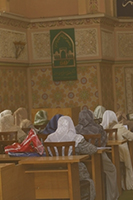
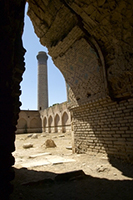 .
.
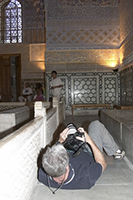
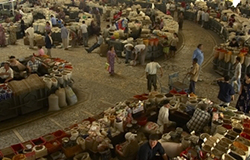 The markets of central Asia are incredible. Filled
with people, shopping or selling everything from clothing to food,
the markets offered a variety of lighting conditions and a plethora
of colors. I used a 580EZ flalsh often set for fill-flash, and
I frequently set the flash so that the built-in diffusion screen
and bounce card directed a softer light. In retrospect, I should
have carried an omnibounce or Reflectasol flash bouncer for better
flash efficiency, but the rig I used worked, and it was simple
to carry. Much of the time I used a 28-300 zoom, although toward
the end of the trip I often carried two cameras, one mounted with
a 2.8 17-35, and the other with a 2.8 70-200, so that I could
more accurately focus in dim light. Since I was shooting fast,
and shooting candids most often and in crowded conditions, I couldn't
use a tripod. In fact, I only used the small Mountaineer carbon-fiber
tripod and AcraTech ballhead twice on the trip, for photographing
spiders and dragonflies on the third day. Image-Stabilization
certainly helped, as did the ability to raise the ISO as needed
for the lighting. I only had a few images that were blurred toss-outs.
The markets of central Asia are incredible. Filled
with people, shopping or selling everything from clothing to food,
the markets offered a variety of lighting conditions and a plethora
of colors. I used a 580EZ flalsh often set for fill-flash, and
I frequently set the flash so that the built-in diffusion screen
and bounce card directed a softer light. In retrospect, I should
have carried an omnibounce or Reflectasol flash bouncer for better
flash efficiency, but the rig I used worked, and it was simple
to carry. Much of the time I used a 28-300 zoom, although toward
the end of the trip I often carried two cameras, one mounted with
a 2.8 17-35, and the other with a 2.8 70-200, so that I could
more accurately focus in dim light. Since I was shooting fast,
and shooting candids most often and in crowded conditions, I couldn't
use a tripod. In fact, I only used the small Mountaineer carbon-fiber
tripod and AcraTech ballhead twice on the trip, for photographing
spiders and dragonflies on the third day. Image-Stabilization
certainly helped, as did the ability to raise the ISO as needed
for the lighting. I only had a few images that were blurred toss-outs.




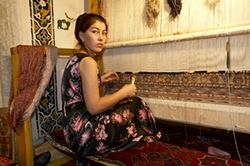

 In Tashkent I visited an artist colony, a series
of small shops that surrounded an ancient courtyard, where artesans
of wood, metal, and painting worked daily. The craftsmanship was
unequalled -- bookstands, originally made for the Koran, were
carved from a single block of wood but unfolded into an X shape
that could be adjusted into as many as eight positions, depending
upon the size and weight of the book in use.When I returned home
and showed one of these to Mary it took us five minutes or so
just to change the shape one time, and I don't think we ever mastered
the eight options. Consider then, how in the world do you carve
something like that with a single, contiguous piece of wood? Photos
at the shop were especially intriguing as I could get in close,
bounce a flash, and use a wide zoom to catch both the artist and
the environment. Still, the images don't do the location or the
artists' justice, as the intricacies of their work was simply
too fine, and too incredible, to depict.
In Tashkent I visited an artist colony, a series
of small shops that surrounded an ancient courtyard, where artesans
of wood, metal, and painting worked daily. The craftsmanship was
unequalled -- bookstands, originally made for the Koran, were
carved from a single block of wood but unfolded into an X shape
that could be adjusted into as many as eight positions, depending
upon the size and weight of the book in use.When I returned home
and showed one of these to Mary it took us five minutes or so
just to change the shape one time, and I don't think we ever mastered
the eight options. Consider then, how in the world do you carve
something like that with a single, contiguous piece of wood? Photos
at the shop were especially intriguing as I could get in close,
bounce a flash, and use a wide zoom to catch both the artist and
the environment. Still, the images don't do the location or the
artists' justice, as the intricacies of their work was simply
too fine, and too incredible, to depict.
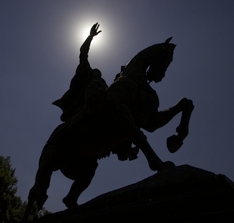
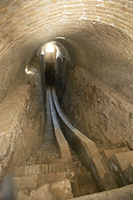
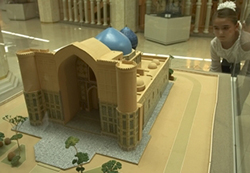
This same sense of fine art is evidenced in their ancient Mosques. Much of Uzbekistan was leveled by Genghis Khan in the early Middle Ages, but was rebuilt in superlative fashion by the country's national hero, Amir Timor, who united the country and ended up conquering much of the Middle East, from Turkey to southern Russia almost one thousand years ago. Timor and his descendents built numerous mosques, and many of these, neglected now for centuries, are being refurbished to their original grandeur. They were spectacular. One of Timor's descendents, Ulugubek, invented the navigational tool, the sextant, and he also built an incredible observatory that I couldn't quite figure out. At its base a long sweeping tunnel of at least 100 feet curves underground in a shape suggestive of the sextant, and in some way, I'm sure, this was used as a celestial guide. Awesome engineering, even if I couldn't understand exactly how it worked.
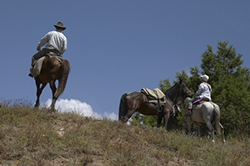
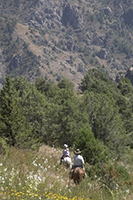
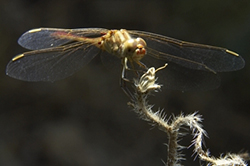
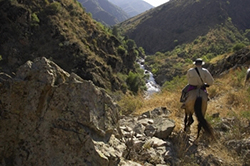 tural history, and my first few days in the country
were spent in a national park not open to the public. Here, in
Chitkal, we rode up into the high country for two days almost
to timberline, to get a feel for the land and perhaps, remotely,
to see some sign of the snow leopards that may be found here.
It's very hot in early August in much of Uzbekistan, and any mammals
that would be about would most likely do so after dark. I did
see a Eurasian badger, and one in our group spotted a deer, but
otherwise mammal life was scarce. I only saw a few species of
birds, and the scarcity of bird life was odd, especially considering
the absolute abundance of insect life. I was puzzled, too, by
the complete absense of reptiles, for many of the areas looked
remarkably like Zion National Park, Utah, where at this season
and elevation I'd have seen dozens of lizards. Ubekistan's reptile
life is actually quite diverse, with around 140 different species
ranging from agamas and monitors to cobras and adders, but I saw
nothing.
tural history, and my first few days in the country
were spent in a national park not open to the public. Here, in
Chitkal, we rode up into the high country for two days almost
to timberline, to get a feel for the land and perhaps, remotely,
to see some sign of the snow leopards that may be found here.
It's very hot in early August in much of Uzbekistan, and any mammals
that would be about would most likely do so after dark. I did
see a Eurasian badger, and one in our group spotted a deer, but
otherwise mammal life was scarce. I only saw a few species of
birds, and the scarcity of bird life was odd, especially considering
the absolute abundance of insect life. I was puzzled, too, by
the complete absense of reptiles, for many of the areas looked
remarkably like Zion National Park, Utah, where at this season
and elevation I'd have seen dozens of lizards. Ubekistan's reptile
life is actually quite diverse, with around 140 different species
ranging from agamas and monitors to cobras and adders, but I saw
nothing.I asked everyone in the park whether or not they'd ever seen a snow leopard. One of the scientists who works there, Alexander Esipov, had indeed seen three or four, with one only a few meters away. He's a marmot researcher and I'd suspect in the high country where marmots live, it'd be possible to find a snow leopard hunting marmots, much as an African leopard hunts hyraxes. Winter is best, I was told, but in winter the area we traveled would be snow-covered and difficult or dangerous to travel by the horses that had brought us up into the high country. On our second day we rode for almost seven hours of an eight-hour field day. I'm lucky to ride a horse every other year, and while I think I'm competent, our rides here were probably as challenging as one will ever have on a horse. We rode up steep hillsides, down sharp inclines, and across cliff edges that would surely tax the steadiness of anyone with acrophobia. On our first day, our ride concluded long after sunset and we rode down the mountain in what, to us, was complete darkness. The horses, with 'four wheel drive,' did fine, occasionally slipping, but never really losing their feet, but we had to take their competence on faith, for we couldn't see a thing. In the light of the next day we ascended the mountain via the route the horses descended in darkness, and the magnitude of their accomplishment (or the insanity of our ride) was readily apparent.
Chilkut, where we did our riding, is a bowl-shaped park, with the park's boundaries defined by the highest elevation of the park's ridges. Lammergiere, or bearded vultures, glide the high country, but I missed this, one of the world's largest vultures and one I had hoped to see. Asiatic white-headed vultures, greater kestrils, and one larger falcon, a few doves, a jay-like bird, raven, and many European rollers were the only birds I saw, although I was frustrated by the treefrog-like toots of the little owl, an elf owl-sized bird, that called incestantly from multiple locations at our headquarters. I spent a lot of time searching, but the owl, barely larger than a sparrow, was impossible to see.
In many ways Chilkut reminded me of the high country of Montana or Yellowstone, with pines replaced by juniper trees and, high in the distance, the treeless scree at timberline. Ibex, deer, wild boar, and, of course, snow leopards live in this high country and while I rode, I day-dreamed over what might be required to actually see or photograph this extremely well-camouflaged cat. I'm sure it could be done here, but it would take some time, and the biggest obstacle is that there are no roads for access -- everything is moved by foot or horseback.


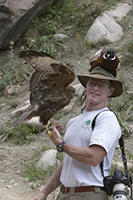
The most exciting 'wildlife' shooting occured in Kyrgyzstan, where we traveled up a long valley surrounded by extremely rugged mountains. The location, near Lake Issik Kul -- a nearly two hundred mile-long lake that is bordered by snow-covered mountains that rise as high as 21,000 feet, was incredibly rugged, and is the home of traditional falconers. The area attracts tourists, and we no sooner arrived than falconers on horseback appeared, with European buzzards (analagous to our redtail hawks or, more properly, rough-legged hawks in appearance) and one golden eagle. The buzzards were incredibly tame, and although treated with respect they were handled in a cavalier fashion I'd never seen with an American falconer, who generally handles their birds with the utmost tenderness. These birds were treated like pet cats or dogs, and seemed to thrive. One falconer carried a buzzard on one shoulder and a ring-necked pheasant on the other, and both coexisted and were handled -- including placing both birds on our heads, with complete sangfroid. I've only 'worked with' pheasants one other time, and then, in the US, the birds were nervous and flighty. This pheasant was completely calm, and I had to wonder if it was handled since the day it hatched to account for this temperament.
Bordering western China, Kyrgyzstan's people were forged by mountains and horses. The entire settled area of the country is one long valley, shared in part by Kazakhstan, that forms virtually the only arable land. The rest is mountains, rugged, steep mountains that during the Soviet era were serviced by roads and trucks that transported shepherds and their herds to high summer pastures. Now, with the breakup of that Union, the high country is neglected while the lower slopes are over-grazed. Kyrgyzstan, like most of Central Asia, is a convoluted land of ridges and mountains, all by-products of the same geologic forces that formed the Himalayas when the Indian subcontinent pushed its way into the Asian landmasses eons ago.
Regardless of its faults, the Soviet Union had some beneficial aspects to these central Asian countries, providing an infrastructure and a market for goods that is declining today. Wool and other sheep products and cotton are two important industries in both countries, and in the past the Union bought these goods as a means to support one of their own states. Now, without the loyalty of the Union, countries buy goods at the most competitive prices, and these former satelite countries suffer. On the dark side, I saw several enormous factories going to ruin. One of these was built in the remote countryside near Chilkut, and this, a huge, block-like edifice, stood out starkly against the dry, desert-like countryside like the obelisk from 2001 A Space Odyssey. It was a depressing-looking structure without a purpose or use in the Uzbekistan of today, one of several that I saw in both countries.
I missed few shooting opportunities, but one that I passed on because of the lateness of the day and the time still required for travel was a haunting vista of the rugged rows of ridges in Kyrgyzstan on our last day in that country as we traveled back to the capital of Bishkek. The scene was reminiscent of the more familiar views one has seen of the Smokies of Tennessee, with black-blue ridge after ridge receeding into the distance, fading gray-blue before finally disappearing in the haze. It was not only a beautiful scene, but the ridges were also extremely evocative, because I knew few westerners, and certainly very few Americans, have ever walked those mountains. I was told there were villages scattered throughout that backcountry, and many might only be accessible by foot or horse. It was snow leopard country to be sure, and that fact, and the beauty of the ridges in the late, golden light were haunting. I hope to see that country again, and much more thoroughly.
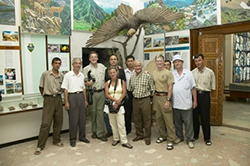 Left: Our group
at the start, in Chilkut.
I must express my thanks and appreciation
to the scientists, faculty, and students that attended the three
lectures I delivered, entitled 'Celebrating Biodiversity,' where
the message I tried to convey was the importance both of habitat
and of the local people in boistering and promoting ecotourism,
and how this ecotourism in its various forms could provide an
economic incentive to protect habitat and, consequently, preserve
biodiversity. I must thank those from the Samarqand State University
and the Tashkent State Agrarian University, both in Uzbekistan,
and the National Academy of Science of Kyrgyzstan for their attendance,
interest, and wonderful questions. Special thanks goes to David
Zuarov, PhD, the project manager who coordinated so much of this
program; as well as Mary Ann Lila, PhD; Khasan Buriev, PhD, head
of the Ubez program; Marietta Eliseyeva, PhD; Igor Belolipov,
PhD; Buston Islamov; who assisted me in many ways throughout my
stay in Uzbekistan and in Samarkand, Ubez., and Jamin Akimaliev,
PhD, who was such a gracious host and guide for our trip to Kyrgyzstan.
Left: Our group
at the start, in Chilkut.
I must express my thanks and appreciation
to the scientists, faculty, and students that attended the three
lectures I delivered, entitled 'Celebrating Biodiversity,' where
the message I tried to convey was the importance both of habitat
and of the local people in boistering and promoting ecotourism,
and how this ecotourism in its various forms could provide an
economic incentive to protect habitat and, consequently, preserve
biodiversity. I must thank those from the Samarqand State University
and the Tashkent State Agrarian University, both in Uzbekistan,
and the National Academy of Science of Kyrgyzstan for their attendance,
interest, and wonderful questions. Special thanks goes to David
Zuarov, PhD, the project manager who coordinated so much of this
program; as well as Mary Ann Lila, PhD; Khasan Buriev, PhD, head
of the Ubez program; Marietta Eliseyeva, PhD; Igor Belolipov,
PhD; Buston Islamov; who assisted me in many ways throughout my
stay in Uzbekistan and in Samarkand, Ubez., and Jamin Akimaliev,
PhD, who was such a gracious host and guide for our trip to Kyrgyzstan.
Most importantly I must again thank Ilya Raskin, PhD, and Rutgers University for this opportunity. It was fantastic, spectacular, and extremely informative, and I hope to get another opportunity to further explore this region in the near future
